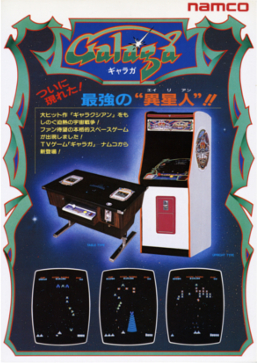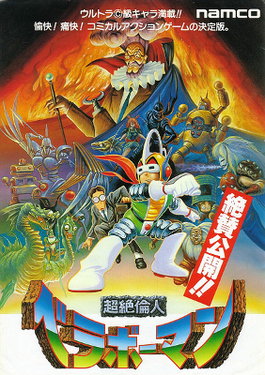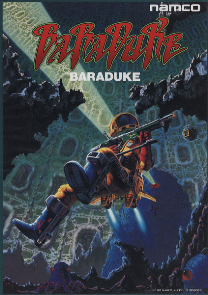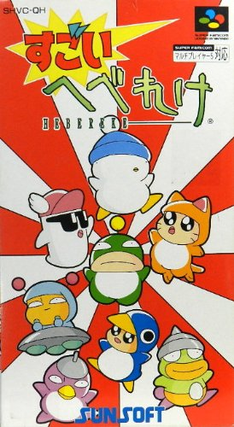A fighting game is a genre of video game that involves combat between two or more characters. Fighting game combat often features mechanics such as blocking, grappling, counter-attacking, and chaining attacks together into "combos". Characters generally engage in battle using hand-to-hand combat—often some form of martial arts. The fighting game genre is related to, but distinct from, the beat 'em up genre, which pits large numbers of computer-controlled enemies against one or more player characters.

Tetris Attack, also known as Panel de Pon in Japan, is a puzzle video game developed by Intelligent Systems and published by Nintendo for the Super Nintendo Entertainment System. A Game Boy version was released a year later. In the game, the player must arrange matching colored blocks in vertical or horizontal rows to clear them. The blocks steadily rise towards the top of the playfield, with new blocks being added at the bottom. Several gameplay modes are present, including a time attack and multiplayer mode.

Galaga is a 1981 fixed shooter arcade video game developed and published by Namco. In North America, it was released by Midway Manufacturing. It is the sequel to Galaxian (1979), Namco's first major video game hit in arcades. Controlling a starship, the player is tasked with destroying the Galaga forces in each stage while avoiding enemies and projectiles. Some enemies can capture a player's ship via a tractor beam, which can be rescued to transform the player into a "dual fighter" with additional firepower.

Pac-Land is a 1984 side-scrolling arcade platform game developed and released by Namco. It was distributed in North America by Bally Midway, and in Europe by Atari Games. Controlling Pac-Man, the player must make it to the end of each stage to return a lost fairy back to its home in Fairyland. Pac-Man will need to avoid obstacles, such as falling logs and water-spewing fire hydrants, alongside his enemies, the Ghost Gang. Eating large flashing Power Pellets will cause the ghosts to turn blue, allowing Pac-Man to eat them for points.

Rally-X is a maze chase arcade video game developed in Japan and Germany by Namco and released in 1980. In North America, it was distributed by Midway Manufacturing and in Europe by Karateco. Players drive a blue Formula One race car through a multidirectional scrolling maze to collect yellow flags. Boulders block some paths and must be avoided. Red enemy cars pursue the player in an attempt to collide with them. Red cars can be temporarily stunned by laying down smoke screens at the cost of fuel. Rally-X is one of the first games with bonus stages and continuously-playing background music.
Super Smash Bros. is a crossover platform fighting game series published by Nintendo. The series was created by Masahiro Sakurai, who has directed every game in the series. The series is known for its unique gameplay objective which differs from that of traditional fighters, in that the aim is to increase damage counters and knock opponents off the stage instead of depleting life bars.

Chōzetsurin Jin Bravoman is a 1988 beat'em up arcade video game developed and published in Japan by Namco. Described as a "comical action game", the player controls the titular character, a bionic superhero with telescopic limbs, as he must defeat the villainous Dr. Bomb before he takes over the world. Bravoman can use his arms, legs and head to defeat enemies, and can also crouch and jump over them. The game ran on the Namco System 1 arcade board.

The Tower of Druaga is a 1984 arcade action role-playing maze game developed and published in Japan by Namco. Controlling the golden-armored knight Gilgamesh, the player is tasked with scaling 60 floors of the titular tower in an effort to rescue the maiden Ki from Druaga, a demon with eight arms and four legs, who plans to use an artifact known as the Blue Crystal Rod to enslave all of mankind. It ran on the Namco Super Pac-Man arcade hardware, modified with a horizontal-scrolling video system used in Mappy.

Baraduke, renamed Alien Sector in some regions, is a run and gun video game released for arcades by Namco in 1985. A home version was published for the X68000.

Dragon Spirit is a 1987 vertical-scrolling shooter arcade game developed and published by Namco. In North America, it was distributed by Atari Games. Controlling the dragon Amur, the player must complete each of the game's nine areas to rescue the princess Alicia from the demon Zawell. Similar to Namco's own Xevious, Amur has a projectile weapon for destroying air-based enemies and a bomb for destroying ground enemies. It ran on the Namco System 1 arcade board.

Namco Classic Collection Vol. 1 is a 1995 arcade game compilation developed and published by Namco. It includes three of the company's most well-known games from the early 1980s — Galaga (1981), Xevious (1983), and Mappy (1983) — alongside brand-new "Arrangement" remakes of these games that have updated gameplay, visuals, and sounds. The arcade originals are also modified slightly to end after a certain number of rounds. Super Xevious (1984) is also playable. It ran on the Namco ND-1 arcade system, being one of the first games to utilize it.
A side-scrolling video game is a game viewed from a side-view camera angle where the screen follows the player as they move left or right. The jump from single-screen or flip-screen graphics to scrolling graphics during the golden age of arcade games was a pivotal leap in game design, comparable to the move to 3D graphics during the fifth generation.

The Mysterious Murasame Castle is an action-adventure video game developed by Nintendo and Human Entertainment and published by Nintendo for the Family Computer Disk System. It was released exclusively in Japan on April 14, 1986. The game was one of the early games released for the system, and the second original game after The Legend of Zelda. The game was released outside Japan for the first time on the Nintendo 3DS Virtual Console in Europe and Australia in May 2014 and in North America in August 2014. It was added to the Nintendo Switch Online service on October 31, 2023.

Super Smash Bros. is a 1999 crossover fighting game developed by HAL Laboratory and published by Nintendo for the Nintendo 64. It was first released in Japan on January 21, 1999, in North America on April 26, 1999, and in Europe on November 19, 1999. The first installment in the Super Smash Bros. series, it is a crossover between several different Nintendo franchises, including Mario, The Legend of Zelda, Star Fox, Yoshi, Donkey Kong, Metroid, F-Zero, Mother, Kirby, and Pokémon. It presents a cast of characters and locations from these franchises and allows players to use each character's unique skills and the stage's hazards to inflict damage, recover health, and ultimately knock opponents off the stage.

Tank! Tank! Tank! is a 2009 third-person shooter arcade game developed and published by Namco Bandai Games. It was ported to the Wii U in 2012, where it was a system launch title in North America. Players control their respective tanks and must destroy opponents and giant mechanical monsters with a variety of weapons, such as machine guns and rocket launchers. Its gameplay has been compared to titles such as the Earth Defense Force series, through its usage of B-movie tropes and parodying.

The Ninja Warriors is a beat 'em up video game developed by Natsume for the Super Nintendo Entertainment System and published by Taito in Japan and North America in 1994 and by Titus in Europe in 1995. It is a follow-up to Taito's 1987 arcade game of the same title, and shares similar gameplay. The player can choose between playing as one of three ninja androids, each with different attributes and a unique set of moves including jumps, dashes, throws, and other attacks. The game was developed by the same team at Natsume that later developed Wild Guns (1994).

Sugoi Hebereke is a 1994 fighting game developed and published by Sunsoft in Japan for the Super Famicom on March 11, 1994. It is a spin-off of the Hebereke series, as well as Sunsoft's first attempt in the genre before they became better known for the 1995 Galaxy Fight: Universal Warriors, the 1996 Waku Waku 7, and the 1998 Astra Superstars.

Dancing Eyes is a 1996 puzzle arcade video game developed and published in Japan by Namco. It features gameplay reminiscent of arcade games like Qix — players control a monkey named Urusu-San as he must complete each level by destroying all of the tiles off the grid of a 3D object. Most levels revolve around the player slowly removing the clothing off of women, alongside destroying cobras, UFOs, and cardboard boxes. There are enemies that must be avoided, and there are also power-ups that grant different abilities. The game runs on the Namco System 11 hardware.

Bandai Namco Studios Inc. is a Japanese video game developer headquartered in Kōtō, Tokyo. Its offices in Malaysia and Singapore, Bandai Namco Studio Malaysia and Bandai Namco Studios Singapore, are based out of Selangor, Malaysia and Infinite Studios, Singapore respectively. Bandai Namco Studios is a subsidiary of Bandai Namco Entertainment, which itself is a subsidiary of Bandai Namco Holdings. The company works under its parent company as a keiretsu; Bandai Namco Studios creates video games for home consoles, handheld systems, mobile devices and arcade hardware, while Bandai Namco Entertainment handles the managing, marketing and publishing of these products.

Captain Commando is a 1991 futuristic side-scrolling beat 'em up originally developed and published by Capcom as an arcade video game, and later ported to several other platforms. It was the seventeenth game produced for the company's CP System hardware. The game stars the titular superhero who was originally conceived as a fictional spokesman used by Capcom USA in the company's console games during the late 1980s. On September 13, 2018, Capcom announced Capcom Beat 'Em Up Bundle with Captain Commando being one of seven titles and released digitally for Nintendo Switch, PlayStation 4, Xbox One, and Windows on September 18, 2018.

















